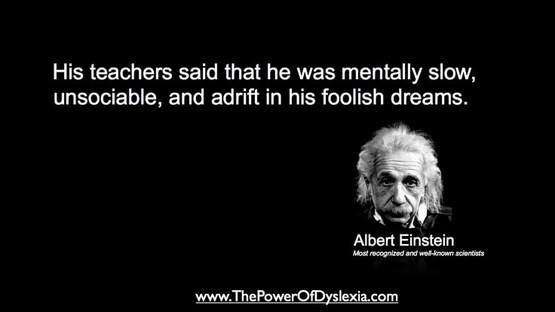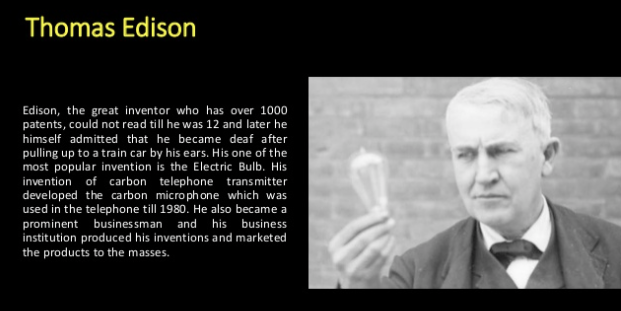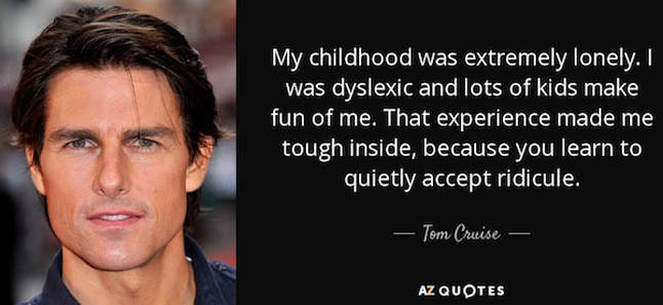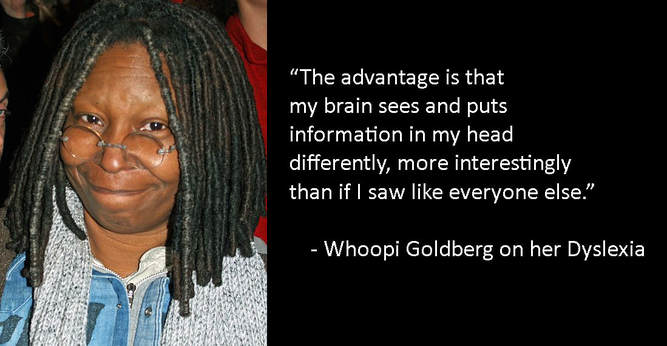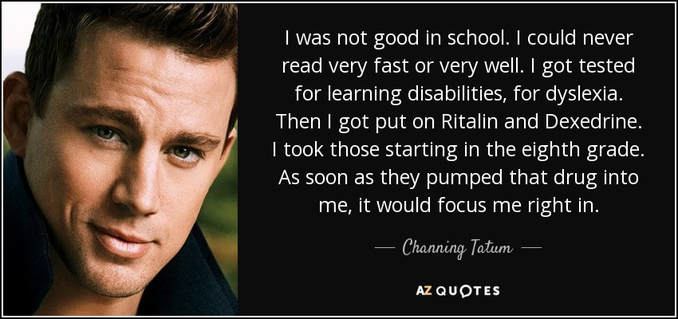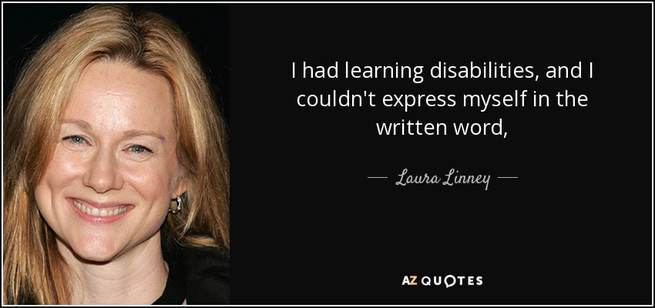Thinking & Finding an ‘Outside of the Box’ Solution
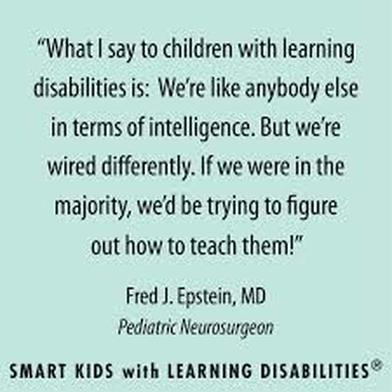
Please note that I am not an educator or evaluator. I'm also not an expert in either of those fields. I'm just a Deaf parent with a visual processing disorder and a slow processing speed. DJK, my Deaf daughter, has the same diagnosis. I've navigated this journey like a puzzle over the years, trying to improve coping strategies, compensate for academic challenges, and find a reading solution for DJK. For nearly 20 years, I worked as an ADA Accessibility Advisor in a postsecondary institution's accessibility services office, where I also provided accommodations for students with disabilities. As a "multiple role," I have access to resources that may benefit deaf and hard of hearing individuals with learning disabilities.
DJK was not thrilled with the prospect of this website. However, I felt that the Deaf community needs to be more aware of learning disabilities, particularly in the field of Deaf Education. My daughter was diagnosed with learning disabilities as a freshman in high school. She met a junior with learning disabilities shortly after her diagnosis. DJK was shown a writing assignment in which she discussed her learning disabilities and how her parents didn't know what to do or how to help her. I was discouraged by the student's experience and would like to share the resources I have with families who have a child with a learning disability.
Growing up with learning disabilities, I encountered many people who did not believe learning disabilities existed in the Deaf community. As an adult, I was frequently told, "You look so smart," and "You don't look like you have a learning disability." In fact, people with learning disabilities are found to have average or above-average intelligence. On the other hand, they process information differently and learn differently. Autism and intellectual disability should not be confused with learning disabilities.
According to a parent of two Deaf children dealing with educational issues, Deaf Education teachers are unfamiliar with learning disability issues. According to Busch (2012), "a child who is deaf or hard of hearing is more likely than a child with typical hearing to have a learning disability" (p.1). If you notice a student struggling in class, this is something to keep in mind. According to the study, 50% of Deaf Education teachers did not believe they were adequately prepared to teach deaf and hard of hearing students with learning disabilities. They require more training in the areas of identification, assessment, and intervention (Soukup & Feinstein, 2007). According to another study, 'deaf children may be at greater risk for learning disabilities than hearing children.' Their hearing loss is frequently linked to other neurological deficiencies (Calderon, 1998). This is concerning as the parent of a child with learning disabilities who attends a deaf school.
DJK was not thrilled with the prospect of this website. However, I felt that the Deaf community needs to be more aware of learning disabilities, particularly in the field of Deaf Education. My daughter was diagnosed with learning disabilities as a freshman in high school. She met a junior with learning disabilities shortly after her diagnosis. DJK was shown a writing assignment in which she discussed her learning disabilities and how her parents didn't know what to do or how to help her. I was discouraged by the student's experience and would like to share the resources I have with families who have a child with a learning disability.
Growing up with learning disabilities, I encountered many people who did not believe learning disabilities existed in the Deaf community. As an adult, I was frequently told, "You look so smart," and "You don't look like you have a learning disability." In fact, people with learning disabilities are found to have average or above-average intelligence. On the other hand, they process information differently and learn differently. Autism and intellectual disability should not be confused with learning disabilities.
According to a parent of two Deaf children dealing with educational issues, Deaf Education teachers are unfamiliar with learning disability issues. According to Busch (2012), "a child who is deaf or hard of hearing is more likely than a child with typical hearing to have a learning disability" (p.1). If you notice a student struggling in class, this is something to keep in mind. According to the study, 50% of Deaf Education teachers did not believe they were adequately prepared to teach deaf and hard of hearing students with learning disabilities. They require more training in the areas of identification, assessment, and intervention (Soukup & Feinstein, 2007). According to another study, 'deaf children may be at greater risk for learning disabilities than hearing children.' Their hearing loss is frequently linked to other neurological deficiencies (Calderon, 1998). This is concerning as the parent of a child with learning disabilities who attends a deaf school.
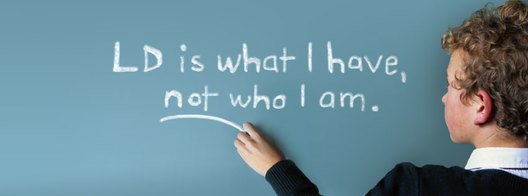
I will comment briefly on DJK's journey out of respect, privacy, and protection. I included her because I wanted to confirm that we have the same diagnosis and that learning disabilities do exist in the Deaf population. Learning disabilities run in families, but our experiences and journeys are and will be unique. For years, she had been frustrated by teachers who consistently looked down on her. She was tired of protecting herself and hiding her academic difficulties. A Deaf child raised by Deaf parents typically excels academically. She compared her academic progress to that of other Deaf children and was disappointed that she did not progress as quickly. After reading this article, I ask that she be respected and not treated differently.
For years, I suspected DJK had a visual processing disorder, but I was skeptical until the high school psychologist confirmed her diagnosis. I was hoping that with extensive tutoring in middle school, she would be able to overcome her reading difficulties. However, her challenges persisted throughout her first year of high school, so I referred her to a school psychologist for an evaluation to determine whether she had learning disabilities. During the evaluation, her psychologist immediately identified DJK's visual perception issues and concluded that she did not have an attitude or behavior problem, as several of her teachers claimed. Teachers assumed she was lazy or didn't put in enough effort. The psychologist observed that she used her attitude to protect herself and to conceal her learning difficulties. What an accurate observation! I should have known better. I'm grateful for the psychologist's accurate assessment because we didn't have any issues with her behavior at home. She was a sweet young woman who always pitched in around the house without being asked. DJK was incredibly fortunate to have him as an evaluator who understood her situation.
I was heartbroken when I received the final report on her diagnosis and realized that I didn't want her to follow in my footsteps. I became desperate in my search for a "out of the box" way to help her with her reading (i.e., the Irlen Method, magnifying bars, enlarged fonts for reading). "Mom, stop being obsessed with learning disabilities. I am fine," she said. "Learning disability is what I have, not who I am." I happened to find a similar quote on the Internet, as shown in the picture above. Isn't she smart?!
For years, I suspected DJK had a visual processing disorder, but I was skeptical until the high school psychologist confirmed her diagnosis. I was hoping that with extensive tutoring in middle school, she would be able to overcome her reading difficulties. However, her challenges persisted throughout her first year of high school, so I referred her to a school psychologist for an evaluation to determine whether she had learning disabilities. During the evaluation, her psychologist immediately identified DJK's visual perception issues and concluded that she did not have an attitude or behavior problem, as several of her teachers claimed. Teachers assumed she was lazy or didn't put in enough effort. The psychologist observed that she used her attitude to protect herself and to conceal her learning difficulties. What an accurate observation! I should have known better. I'm grateful for the psychologist's accurate assessment because we didn't have any issues with her behavior at home. She was a sweet young woman who always pitched in around the house without being asked. DJK was incredibly fortunate to have him as an evaluator who understood her situation.
I was heartbroken when I received the final report on her diagnosis and realized that I didn't want her to follow in my footsteps. I became desperate in my search for a "out of the box" way to help her with her reading (i.e., the Irlen Method, magnifying bars, enlarged fonts for reading). "Mom, stop being obsessed with learning disabilities. I am fine," she said. "Learning disability is what I have, not who I am." I happened to find a similar quote on the Internet, as shown in the picture above. Isn't she smart?!
What is Visual Processing Disorder and How Does It Affect Learning?
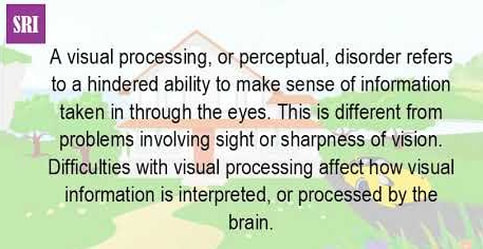
Visual processing disorder, also known as perceptual disorder, describes how the brain interprets or processes visual information. They may have 20/20 vision; it is not an optical (vision) problem. It's a problem with the brain's ability to interpret and process visual information from the eyes. It is the capability of recognizing, tracking, remembering, and interpreting visual information.
The common symptoms of visual processing issues are:
More symptoms can be found in the eight different types of visual processing disorder. Visual processing disorder causes difficulty with reading, writing, spelling, and math. It is not associated with dyslexia (reading disability).
There are eight types of visual processing issues, as quoted from the "Understood for Learning & Attention Issues" link, and they are:
People can have more than one type of visual processing difficulty. PleaseVisit the link for more information about each type of visual processing disorder and how it affects learning. It is quite common for visual processing disorder to go undiagnosed or untreated because it is difficult to detect the perception issues and it does not show up on vision tests.
Parents
Parents should keep track of their child's visual processing issues or symptoms, as well as how they affect reading comprehension, math achievement, and social development. They can talk to the child's teacher about any processing difficulties he or she has noticed in the classroom and see if these issues are impeding the child's academic progress. The same can be said for the teachers.
Parents are the best advocates for their children. If the school assures you that nothing is wrong with a child, but you have a different impression. You can request an evaluation for visual processing issues. Keep in mind that poor vision and visual processing disorder are two separate issues that will involve different treatments. It is crucial to have your child's vision checked to rule out any vision or eye problems. If the child's vision is not an issue, you can talk to the school about having him or her tested for possible processing issues. Be proactive and trust your instincts. As stated in the "About Deaf/LD" section, you will want to ensure that the child's diagnosis is included in the evaluation report.
Teachers
When working with students, teachers need to keep the eight types of visual processing issues in mind and ask them (and parents, too) for a description of how they read a book—skipping lines/words, being distracted by visual stimuli, and so on. Teachers (and parents) can raise concerns about the student's processing issues in the classroom and discuss intervention with a parent. A link to guides highlighting common warning signs of visual processing issues at various ages is included.
Tools/Accommodations
The lists of tools and accommodations the child can use are:
More accommodations and tools are listed in the "Resources/Services" section. Intervention and solution-finding will make a difference in the life of deaf and hard-of-hearing students who struggle with visual processing issues or other types of learning disabilities.
The common symptoms of visual processing issues are:
- Difficulty paying attention to visual tasks
- Easily distracted/overwhelmed by too much visual stimuli
- Inability to discriminate differences in letters, shapes, or objects
- Reversing/misreading letters, numbers, and words
- Omitting words or letters
- Skipping lines and words
- Poor spatial awareness
- Poor handwriting
- Inaccurate placement on lines
- Straining/rubbing eyes and mental fatigue
More symptoms can be found in the eight different types of visual processing disorder. Visual processing disorder causes difficulty with reading, writing, spelling, and math. It is not associated with dyslexia (reading disability).
There are eight types of visual processing issues, as quoted from the "Understood for Learning & Attention Issues" link, and they are:
- Visual discrimination issues - Difficulty seeing the difference between similar letters, shapes or objects; may mix up letters, confusing d and b, or p and q
- Visual figure-ground discrimination issues - Difficulty distinguishing a shape or letter from its background; may have trouble finding a specific piece of information on a page
- Visual sequencing issues - Difficulty seeing shapes, letters, or words in the correct order; may skip lines or read the same line over and over and reverse or misread letters, numbers and words
- Visual-motor processing issues - Difficulty using what they see to coordinate with the way they move; may struggle to write within lines or bump into objects while walking and have trouble coping from a book
- Long-or-short-term visual memory issues - Difficulty recalling shapes, symbols, or objects they have seen; may struggle with reading and spelling
- Visual-spatial issues - Trouble understanding where objects are in space, unsure how close objects are to one another. That includes how far things are from them and from each other. It also includes objects and characters described on paper or in a spoken narrative. Difficulty reading maps and judging time
- Visual closure issues - Difficulty identifying an object when only parts of it are showing; may not recognize a truck if it’s missing wheels. Or a person in a drawing that is missing a facial feature. They may also have great difficulty with spelling because they can’t recognize a word if a letter is missing
- Letter and symbol reversal issues - Switch numbers or letters when writing, or may mistake “b” for “d” or “w” for “m” to switch letters or numbers when writing. They also have trouble with letter formation that affects reading, writing and math skills
People can have more than one type of visual processing difficulty. PleaseVisit the link for more information about each type of visual processing disorder and how it affects learning. It is quite common for visual processing disorder to go undiagnosed or untreated because it is difficult to detect the perception issues and it does not show up on vision tests.
Parents
Parents should keep track of their child's visual processing issues or symptoms, as well as how they affect reading comprehension, math achievement, and social development. They can talk to the child's teacher about any processing difficulties he or she has noticed in the classroom and see if these issues are impeding the child's academic progress. The same can be said for the teachers.
Parents are the best advocates for their children. If the school assures you that nothing is wrong with a child, but you have a different impression. You can request an evaluation for visual processing issues. Keep in mind that poor vision and visual processing disorder are two separate issues that will involve different treatments. It is crucial to have your child's vision checked to rule out any vision or eye problems. If the child's vision is not an issue, you can talk to the school about having him or her tested for possible processing issues. Be proactive and trust your instincts. As stated in the "About Deaf/LD" section, you will want to ensure that the child's diagnosis is included in the evaluation report.
Teachers
When working with students, teachers need to keep the eight types of visual processing issues in mind and ask them (and parents, too) for a description of how they read a book—skipping lines/words, being distracted by visual stimuli, and so on. Teachers (and parents) can raise concerns about the student's processing issues in the classroom and discuss intervention with a parent. A link to guides highlighting common warning signs of visual processing issues at various ages is included.
Tools/Accommodations
The lists of tools and accommodations the child can use are:
- Use large-print books (Kurweil 3000 software is a good option)
- Use a line tracker to keep track of reading
- Try different type of papers, such as graph paper or colored paper
- Provide an alternative option to written assignments (word processor, Grammarly software)
More accommodations and tools are listed in the "Resources/Services" section. Intervention and solution-finding will make a difference in the life of deaf and hard-of-hearing students who struggle with visual processing issues or other types of learning disabilities.
Deaf Education: A New Philosophy
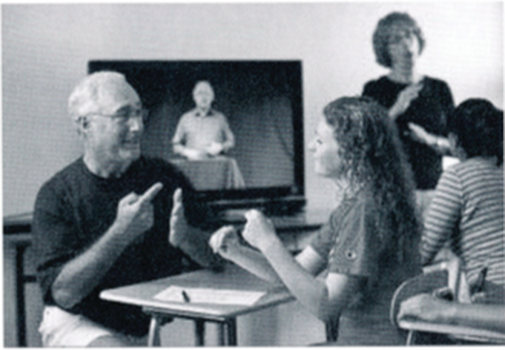 The Endeavor, Winter 2011
The Endeavor, Winter 2011
I felt relieved and liberated after reading an article by Greg Livadas, author of "Deaf Education: A New Philosophy," about the two types of visual processing issues:
1. Visual-Spatial
2. Visual Sequence
When you think about it, Deaf students naturally have strong spatial skills and excel in math, sports, and directions. Given our visual-spatial disorder, we clearly
The study addressed the fact that "deaf people have better visual-spatial memories than hearing people, but their sequential memory isn't as good" (Livadas, The Endeavor, Winter 2011, p. 52). The author added that deaf students have difficulty retaining sequences and are encouraged to use "visual and spatial material" in the classroom (Livadas, The Endeavor, Winter 2011, p. 53).
According to this article, deaf people have better visual-spatial skills than hearing people, and hearing people have better visual sequential memory for reading, writing, and spelling.
I appreciate that the author recognized those two crucial types of learning and how they help with their academic progress.
That being said, keep those eight types of visual processing issues in mind when working with a student and provide any necessary interventions. These are the most commonly overlooked issues. A copy of the article is enclosed. It's a good article, and I recommend reading it.
1. Visual-Spatial
2. Visual Sequence
When you think about it, Deaf students naturally have strong spatial skills and excel in math, sports, and directions. Given our visual-spatial disorder, we clearly
The study addressed the fact that "deaf people have better visual-spatial memories than hearing people, but their sequential memory isn't as good" (Livadas, The Endeavor, Winter 2011, p. 52). The author added that deaf students have difficulty retaining sequences and are encouraged to use "visual and spatial material" in the classroom (Livadas, The Endeavor, Winter 2011, p. 53).
According to this article, deaf people have better visual-spatial skills than hearing people, and hearing people have better visual sequential memory for reading, writing, and spelling.
I appreciate that the author recognized those two crucial types of learning and how they help with their academic progress.
That being said, keep those eight types of visual processing issues in mind when working with a student and provide any necessary interventions. These are the most commonly overlooked issues. A copy of the article is enclosed. It's a good article, and I recommend reading it.
Irlen Method I: An Interesting Evaluation Process
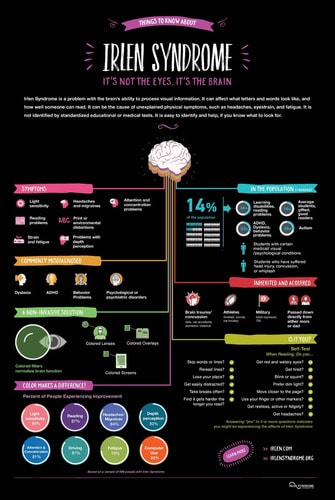 Irlen Poster
Irlen Poster
Irlen Syndrome is a perceptual processing problem that has an impact on academic performance. Irlen Syndrome does not result from a learning disability. However, it is frequently discovered to coexist with learning difficulties. The Irlen Institute offers colored technology (such as colored overlays and filters) to help the brain process visual information more effectively.
As I previously stated, I was attempting to think 'outside the box,' such as special education resource programs, tutoring, accommodations, and so on. I decided to try the Irlen method to see if it would help with DJK's reading while thinking outside the box. I was curious about it as well.
During DJK's spring break in March 2018, we met with Karla Jay, an Irlen screener (there was an ASL interpreter present). I paid for her services because I didn't want to waste time battling about the interpreting request when DJK needed it. I'll have to thank the interpreter for coming on such short notice) to see if we were candidates for Irlen Syndrome. We were later diagnosed with Irlen Syndrome and were Karla's first Deaf customers. She was a breeze to work with. I was so grateful for her offer to fit us into her jam-packed schedule on such short notice.
Our evaluation was an interesting process. During the assessment, several visual tasks were performed using black and white patterns or forms on a glossy page. I outlined the parts of the designs were very hard to look at and commented, “It hurts and is a mess.” We were asked not to use our hands to count. We had to use our head to count parts of the designs. While counting, I noticed that the lines were smashing together. Despite my best efforts, I was unable to fully count the parts of the lines. DJK reported that some of the designs were diifficult to look at and they “changed sizes, pulsed, shrunk and grew.”
When we were asked to count "XXXXXX" on a visual-stimulus background, I could only count the first two X's and the rest of the X's turned into white circles, which was the background information in between the X's. I tried counting the Xs twice and kept seeing white circles that looked like "XX0000." DJK had the same experience, despite the fact that she was a little ahead of me in counting. We were unable to count all of the Xs.
As I previously stated, I was attempting to think 'outside the box,' such as special education resource programs, tutoring, accommodations, and so on. I decided to try the Irlen method to see if it would help with DJK's reading while thinking outside the box. I was curious about it as well.
During DJK's spring break in March 2018, we met with Karla Jay, an Irlen screener (there was an ASL interpreter present). I paid for her services because I didn't want to waste time battling about the interpreting request when DJK needed it. I'll have to thank the interpreter for coming on such short notice) to see if we were candidates for Irlen Syndrome. We were later diagnosed with Irlen Syndrome and were Karla's first Deaf customers. She was a breeze to work with. I was so grateful for her offer to fit us into her jam-packed schedule on such short notice.
Our evaluation was an interesting process. During the assessment, several visual tasks were performed using black and white patterns or forms on a glossy page. I outlined the parts of the designs were very hard to look at and commented, “It hurts and is a mess.” We were asked not to use our hands to count. We had to use our head to count parts of the designs. While counting, I noticed that the lines were smashing together. Despite my best efforts, I was unable to fully count the parts of the lines. DJK reported that some of the designs were diifficult to look at and they “changed sizes, pulsed, shrunk and grew.”
When we were asked to count "XXXXXX" on a visual-stimulus background, I could only count the first two X's and the rest of the X's turned into white circles, which was the background information in between the X's. I tried counting the Xs twice and kept seeing white circles that looked like "XX0000." DJK had the same experience, despite the fact that she was a little ahead of me in counting. We were unable to count all of the Xs.
 Irlen Rivers
Irlen Rivers
On the Dutch and symptoms pages, we saw rivers running down the page. I stated, "The page was blurry, and the small font was visually overwhelming." It irritated me as a young girl to see things like this. Karla claimed that those who are good readers never see rivers. Unlike the font shown in the image, you can see what the rivers look like.
As a result, I had Irlen Syndrome, a visual perceptual disorder that causes strain and fatigue while reading. DJK also had Irlen Syndrome, which is characterized by poor attention to written words, visual-spatial delays, and visual tracking issues. It's no surprise that visual processing disorder has an impact on our math and reading. As I explained in my "Tearing Down the Wall" story, it affected my ability to read recipes, menus, maps, and crowded prints when I was younger.
We were both encouraged to read or take tests with colored overlays. It was also suggested that we change the color of our computer screen's background and buy the Irlen colored glasses.
As a result, I had Irlen Syndrome, a visual perceptual disorder that causes strain and fatigue while reading. DJK also had Irlen Syndrome, which is characterized by poor attention to written words, visual-spatial delays, and visual tracking issues. It's no surprise that visual processing disorder has an impact on our math and reading. As I explained in my "Tearing Down the Wall" story, it affected my ability to read recipes, menus, maps, and crowded prints when I was younger.
We were both encouraged to read or take tests with colored overlays. It was also suggested that we change the color of our computer screen's background and buy the Irlen colored glasses.
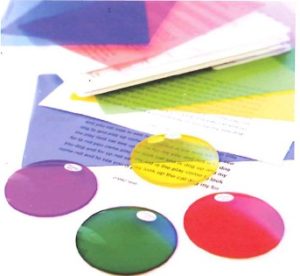 Irlen Colored Overlays & Filters
Irlen Colored Overlays & Filters
To parents, teachers, and psychologists: If you notice any deaf students who are having difficulty reading, you may want to ask for details as to why they are having difficulty reading and request a description of what they see while reading. DJK couldn't read books on his own for years. As a self-taught reader, I encouraged her to read. She, on the other hand, couldn't read them on her own and was easily distracted while reading. Finally, I asked her to describe what she sees while reading. She explained that while reading, she frequently lost her place, misread words, skipped words, missed punctuation marks, and re-read the same sentence. Like mother, like daughter. When I was younger, I had a similar issue. Over time, I learned to compensate for my reading difficulties and eventually improved. Thanks to my enthusiasm for learning! I didn't realize she was going through the same thing until I asked. Why hadn't I thought of that before? DJK's learning symptoms fit the description of a "visual processing disorder," as indicated by the definition of visual processing disorder listed above.
Nevertheless, we should not assume that deaf students' reading difficulties are solely the result of early language deprivation or a lack of early language acquisition exposure. It might be more than just a language barrier. DJK grew up in a Deaf family where they communicated using American Sign Language. She did, however, have visual processing issues that affected her reading. Some deaf students, like her, may have difficulties with visual processing. As previously stated, the majority of students with visual processing issues go unnoticed or unnoticed.
Finally, it is not a bad idea to refer students to Irlen services for confirmation. It is an example of looking for a "out of the box" solution to see if it qualifies for the Irlen method.
If you want to learn more about the Irlen method, visit https://irlen.com. Since 1983, the Irlen Method has been in use. In retrospect, I would have benefited from Irlen color technology. It's better to be late than never.
Nevertheless, we should not assume that deaf students' reading difficulties are solely the result of early language deprivation or a lack of early language acquisition exposure. It might be more than just a language barrier. DJK grew up in a Deaf family where they communicated using American Sign Language. She did, however, have visual processing issues that affected her reading. Some deaf students, like her, may have difficulties with visual processing. As previously stated, the majority of students with visual processing issues go unnoticed or unnoticed.
Finally, it is not a bad idea to refer students to Irlen services for confirmation. It is an example of looking for a "out of the box" solution to see if it qualifies for the Irlen method.
If you want to learn more about the Irlen method, visit https://irlen.com. Since 1983, the Irlen Method has been in use. In retrospect, I would have benefited from Irlen color technology. It's better to be late than never.
Irlen Method II: Our Meeting with the Irlen Syndrome Diagnostician
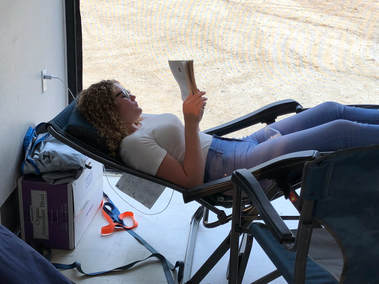 DJK reading a book with her Irlen glasses
DJK reading a book with her Irlen glasses
On July 11, 2018, my daughter, DJK, and I met with Dr. Jeannie Dunn, the Irlen Syndrome diagnostician, to discuss our underlying perceptual processing difficulties and light sensitivity, which have contributed to our reading difficulties, fatigue, and visual strain (an ASL interpreter was arranged). DJK used the overlay color for academics at first (there are ten overlay colors), but she disliked it because it was inconvenient. I suggested she try the colored glasses. She was initially hesitant to accept my recommendation, but she eventually agreed to give it a try. Dr. Dunn displayed her briefcase full of colored lenses during our appointments. If you blended the Spectral Filter colors, there were over 100,000. Our meeting was a lengthy and difficult process. With an infinite number of colors to choose from, it took us hours to find the one that allowed our brain to normalize brain functions. We also had to ensure that the color would not be visible on white paper and that the colored lenses were not too dim or dark. We eventually found the correct color that we were happy with. DJK's color is a combination of two shades of light gray, whereas mine is a combination of three light colors: pink, purple, and yellow. See our photos below.
DJK was astounded by her ability to read with flow and fluency through the colored filtered lenses. She was also able to follow the words and lines without losing her place. DJK was easily distracted and overwhelmed while reading due to the overstimulating background print. As a result, she lost interest in reading. The Irlen glasses help her keep track of what she's reading and improve her comprehension. Despite the amazing results, DJK was once again hesitant to wear the glasses because of her peers. Dr. Dunn persuaded DJK to agree after much persuasion. She has been able to focus on reading and finish the entire book for the first time since getting her Irlen glasses (See the photo of her reading a book with the Irlen glasses). As a mother, I was pleased to see the improvements DJK noticed while wearing her Irlen lenses. I wish I had been aware of the Irlen resources when I was younger. I suppose it's better to be late than never, right?
DJK had agreed to only wear her glasses for academic purposes (i.e., assignments, reading, and tests). She was encouraged to wear them all the time, but she was not comfortable due to peers. I've gotten positive feedback from her teachers ever since school started. They were fascinated by the Irlen resources and conducted their own research. What a fantastic way to raise awareness of Irlen resources!
DJK was astounded by her ability to read with flow and fluency through the colored filtered lenses. She was also able to follow the words and lines without losing her place. DJK was easily distracted and overwhelmed while reading due to the overstimulating background print. As a result, she lost interest in reading. The Irlen glasses help her keep track of what she's reading and improve her comprehension. Despite the amazing results, DJK was once again hesitant to wear the glasses because of her peers. Dr. Dunn persuaded DJK to agree after much persuasion. She has been able to focus on reading and finish the entire book for the first time since getting her Irlen glasses (See the photo of her reading a book with the Irlen glasses). As a mother, I was pleased to see the improvements DJK noticed while wearing her Irlen lenses. I wish I had been aware of the Irlen resources when I was younger. I suppose it's better to be late than never, right?
DJK had agreed to only wear her glasses for academic purposes (i.e., assignments, reading, and tests). She was encouraged to wear them all the time, but she was not comfortable due to peers. I've gotten positive feedback from her teachers ever since school started. They were fascinated by the Irlen resources and conducted their own research. What a fantastic way to raise awareness of Irlen resources!
Did You Know?
According to the Irlen link, ‘Irlen Spectral Filters are individualized, precision-tinted lenses that filter out the offensive wavelengths of light, allowing the brain to process visual information correctly.’
According to the Irlen link, ‘Irlen Spectral Filters are individualized, precision-tinted lenses that filter out the offensive wavelengths of light, allowing the brain to process visual information correctly.’
 Me & my Irlen glasses
Me & my Irlen glasses
When it was my turn to be screened by Dr. Dunn, the Irlen Syndrome Diagnosis Specialist. She stated that she had met many older adults who had dropped out of high school or college, struggled academically, and were unaware of their diagnosis of Irlen Syndrome until much later. She was astounded by my academic achievements. She stated that it takes perseverance and hard work. "It's no wonder I'm always cranky and tired," I said to the interpreter as Dr. Dunn was taking notes. Dr. Dunn's remark validated my years of exhaustion and frustration with academic demands.
Prior to being tested for Irlen, I wore pink-tinted "FL-41" glasses for light sensitivity for three years, from 2015 to 2018. This reduced light sensitivity, which helped with my Meniere's disease, which I've had since 2003. It did not, however, help with my perception issues or night driving. I tried to avoid driving at night whenever possible and felt like a prisoner.
I was unaware of the Irlen option at the time and only learned about it from one of my college students. It intrigued me. I pushed that option to the back of my mind, intending to try it someday. When my daughter was diagnosed with learning disabilities, I decided it was time to try the Irlen Method (rather than vision therapy) and began the evaluation process. My daughter and I had similar experiences with our Irlen glasses. The only difference is that the Irlen glasses help my reading speed and ability to spot printed information material much faster. For example, I frequently lost my place as a result of background stimulation, and it took me some time to decipher the information I was looking for (i.e., menus, recipes, etc.). With Irlen glasses, I no longer have to do that, and it makes a huge difference! Much to my delight, my Irlen glasses also help with night driving by reducing glare and improving contrast. I can drive anywhere at any time of day or night! Last but not least, my Irlen glasses help to reduce my sensitivity to light. What a fantastic combination! Irlen Spectral Filters (glasses) are absolutely worth every penny, and I couldn't live without them!
To summarize, the Irlen Method helps correct a perceptual processing problem as well as address reading, learning, and attention issues, which can affect achievement, learning, and performance in struggling students. It also helps to normalize the brain's ability to process visual information (see picture of brain activity at https://irlen.com/brain-research/, removing stress from the brain and eliminating physical symptoms. Because D/HH people are visual learners, it doesn't hurt to refer them to an Irlen Specialist for screening. The link to take the test to see if you have Irlen Syndrome is enclosed: https://irlen.com/get-tested/
Prior to being tested for Irlen, I wore pink-tinted "FL-41" glasses for light sensitivity for three years, from 2015 to 2018. This reduced light sensitivity, which helped with my Meniere's disease, which I've had since 2003. It did not, however, help with my perception issues or night driving. I tried to avoid driving at night whenever possible and felt like a prisoner.
I was unaware of the Irlen option at the time and only learned about it from one of my college students. It intrigued me. I pushed that option to the back of my mind, intending to try it someday. When my daughter was diagnosed with learning disabilities, I decided it was time to try the Irlen Method (rather than vision therapy) and began the evaluation process. My daughter and I had similar experiences with our Irlen glasses. The only difference is that the Irlen glasses help my reading speed and ability to spot printed information material much faster. For example, I frequently lost my place as a result of background stimulation, and it took me some time to decipher the information I was looking for (i.e., menus, recipes, etc.). With Irlen glasses, I no longer have to do that, and it makes a huge difference! Much to my delight, my Irlen glasses also help with night driving by reducing glare and improving contrast. I can drive anywhere at any time of day or night! Last but not least, my Irlen glasses help to reduce my sensitivity to light. What a fantastic combination! Irlen Spectral Filters (glasses) are absolutely worth every penny, and I couldn't live without them!
To summarize, the Irlen Method helps correct a perceptual processing problem as well as address reading, learning, and attention issues, which can affect achievement, learning, and performance in struggling students. It also helps to normalize the brain's ability to process visual information (see picture of brain activity at https://irlen.com/brain-research/, removing stress from the brain and eliminating physical symptoms. Because D/HH people are visual learners, it doesn't hurt to refer them to an Irlen Specialist for screening. The link to take the test to see if you have Irlen Syndrome is enclosed: https://irlen.com/get-tested/
Enlarged Font: Makes It Easier to Read
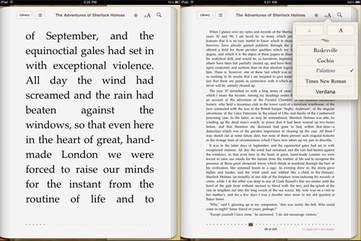
The Irlen resources helped me further analyze my surroundings and make additional modifications (for example, enlarging my computer font, changing the color screen, and using a magnifying bar) to help my visual stress calm down while reading or working. While reading, I no longer have to squint or tilt my head (It was discovered that people with visual processing disorder usually tilt their heads while reading or looking at things). For the first time in forty-four years, I was able to breathe! Why should we continue to suffer from visual processing limitations when we have resources to make adjustments? I'll have to thank DJK for directing me to Ilren for resources; otherwise, I'd be suffering unnecessarily.
For reading, we use an Irlen Magnifying bar. It adjusts the font size and keeps track of the words and lines as you read. As part of DJK's accommodation, I also inquired with her school about the possibility of providing an enlarged font for textbooks and tests. Naturally, students with low vision and dyslexia are given the 'enlarged font' option. Because of the overly stimulating background, the enlarged font may benefit those with visual processing disorders or reading difficulties by preventing them from missing words or lines while reading. It will, I believe, make reading easier and less distracting.
Hearing students with learning disabilities or issues with visual processing can use online tools to help them read. Many of them, however, provide auditory access. They could also use a different method of processing information, such as audiobooks (listening to textbooks) or Dragon Naturally Speaking (voice recognition while writing a paper). Unfortunately, it is inaccessible to students who are deaf or hard of hearing. The Irlen method and a larger font size may be viable options. It may aid in reducing mental fatigue and/or vision strain while attempting to decipher visual material. Another viable option is to use the Kurzweil 3000 software. It is a product that provides a comprehensive reading, writing, and learning solution for people who have reading disabilities or challenges.
If receiving an "enlarged font" accommodation in a secondary school is not possible, you may want to consider requesting it in a postsecondary institution. I think that I would have done better in high school and college if I had used Irlen color technology and the Kurzweil 3000 software product.
For reading, we use an Irlen Magnifying bar. It adjusts the font size and keeps track of the words and lines as you read. As part of DJK's accommodation, I also inquired with her school about the possibility of providing an enlarged font for textbooks and tests. Naturally, students with low vision and dyslexia are given the 'enlarged font' option. Because of the overly stimulating background, the enlarged font may benefit those with visual processing disorders or reading difficulties by preventing them from missing words or lines while reading. It will, I believe, make reading easier and less distracting.
Hearing students with learning disabilities or issues with visual processing can use online tools to help them read. Many of them, however, provide auditory access. They could also use a different method of processing information, such as audiobooks (listening to textbooks) or Dragon Naturally Speaking (voice recognition while writing a paper). Unfortunately, it is inaccessible to students who are deaf or hard of hearing. The Irlen method and a larger font size may be viable options. It may aid in reducing mental fatigue and/or vision strain while attempting to decipher visual material. Another viable option is to use the Kurzweil 3000 software. It is a product that provides a comprehensive reading, writing, and learning solution for people who have reading disabilities or challenges.
If receiving an "enlarged font" accommodation in a secondary school is not possible, you may want to consider requesting it in a postsecondary institution. I think that I would have done better in high school and college if I had used Irlen color technology and the Kurzweil 3000 software product.
Visual Learning Center
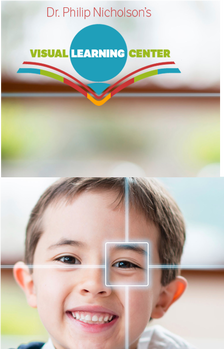
While Googling for more information on visual processing disorder, I came across a website for a "Visual Learning Center" in Olney, Maryland. They offer vision therapy to those who suffer from a visual processing disorder. More information about Vision Therapy can be found at the link provided. I had a deaf college student who is embarrassed by his uncontrollable eye movement problems. His vision, unlike my daughter's, shakes. He wasn't doing anything, not even reading. It must have something to do with his eye-muscle coordination. I recommended vision therapy or eye exercises through YouTube. His face was filled with hope.
When my daughter was first diagnosed with learning disabilities, I was unsure whether to pursue Vision Therapy or Irlen Syndrome for her. I chose the Irlen Method after some research because my daughter attends a deaf school outside of the state. Because of the distance, I couldn't take her to the doctor for vision therapy (eye tracking). In addition, I came across an article on www.understood.org that stated that there is no scientific evidence that vision therapy helps. Visit this website for more information on visual processing issues, where Irlen was recommended in this article.: https://www.understood.org/en/learning-attention-issues/child-learning-disabilities/visual-processing-issues/understanding-visual-processing-issues
Additionally, see the link for more information on 'Treatment Options for Visual Processing Issues.'
This is one of the possibilities for your child. Vision therapy, it appears to me that vision therapy deals with eye-muscle coordination, whereas Irlen Syndrome deals with brain functions.
When my daughter was first diagnosed with learning disabilities, I was unsure whether to pursue Vision Therapy or Irlen Syndrome for her. I chose the Irlen Method after some research because my daughter attends a deaf school outside of the state. Because of the distance, I couldn't take her to the doctor for vision therapy (eye tracking). In addition, I came across an article on www.understood.org that stated that there is no scientific evidence that vision therapy helps. Visit this website for more information on visual processing issues, where Irlen was recommended in this article.: https://www.understood.org/en/learning-attention-issues/child-learning-disabilities/visual-processing-issues/understanding-visual-processing-issues
Additionally, see the link for more information on 'Treatment Options for Visual Processing Issues.'
This is one of the possibilities for your child. Vision therapy, it appears to me that vision therapy deals with eye-muscle coordination, whereas Irlen Syndrome deals with brain functions.
Benefits of Kurzweil 3000 Software
Coming soon!
I'll keep posting my findings. Please come and visit us!
References
Busch, S.N. (2012). Students who are deaf/hard of hearing with learning challenges: Strategies for classroom instruction. Washington University School of Medicine in St. Louis.
Calderon, R. (1998). Learning disability, neuropsychology, and deaf youth: Theory, research, and practice. Children’s Hospital and Medical Center, University of Washington. Oxford University Press. CCC 1081-4159.
Livadas, G. (2011). Deaf Education: A New Philosophy. The Endeavor. American Society for Deaf Children, 51-55.
Soukup, M. & Feinstein, S. (2007). Identification, assessment, and intervention strategies for deaf and hard of hearing students with learning disabilities. PubMED.
